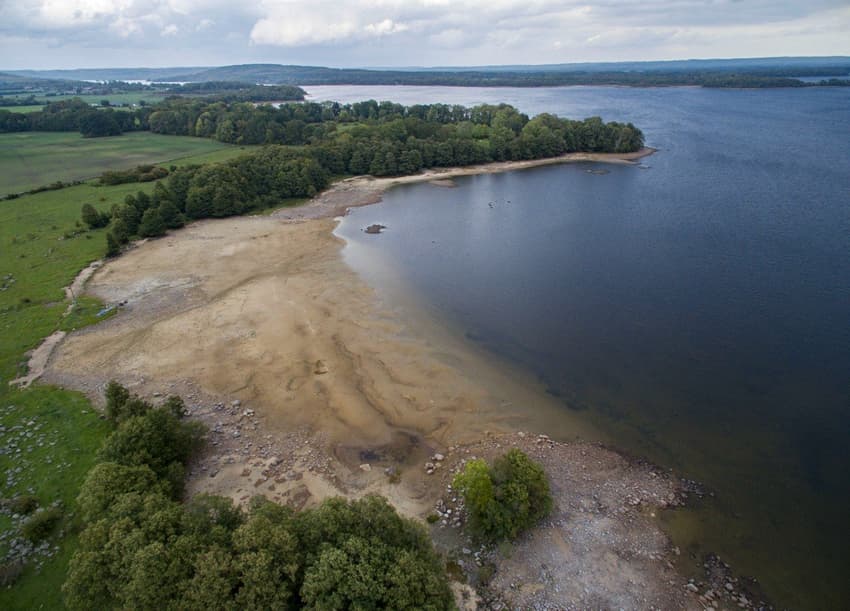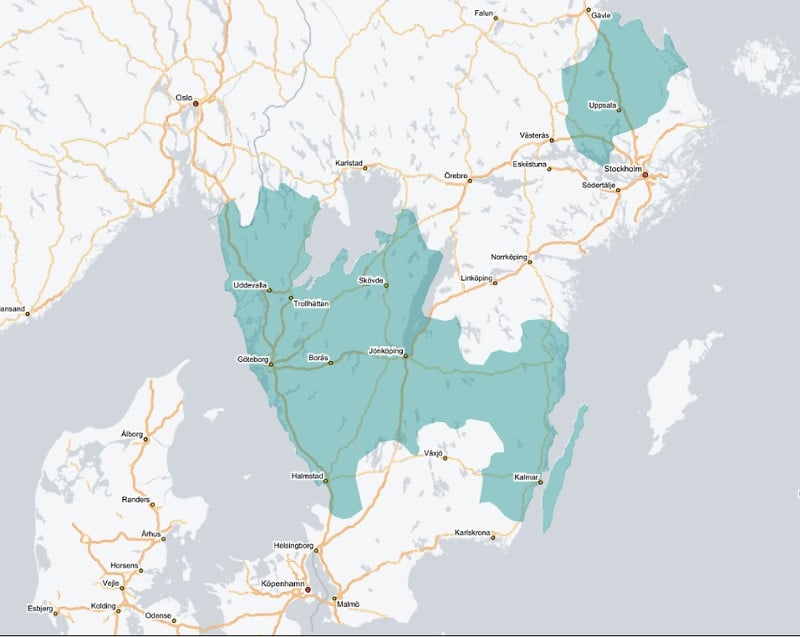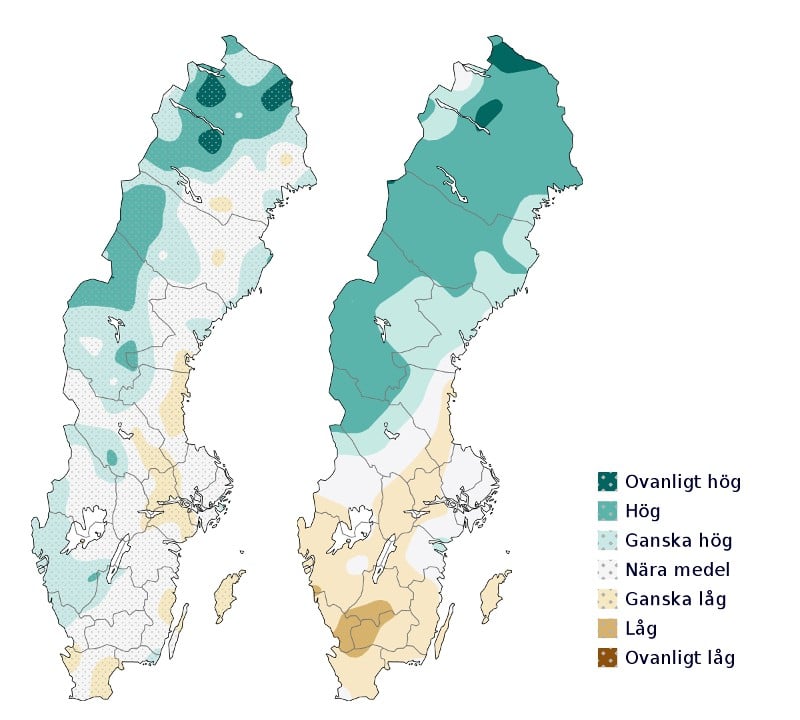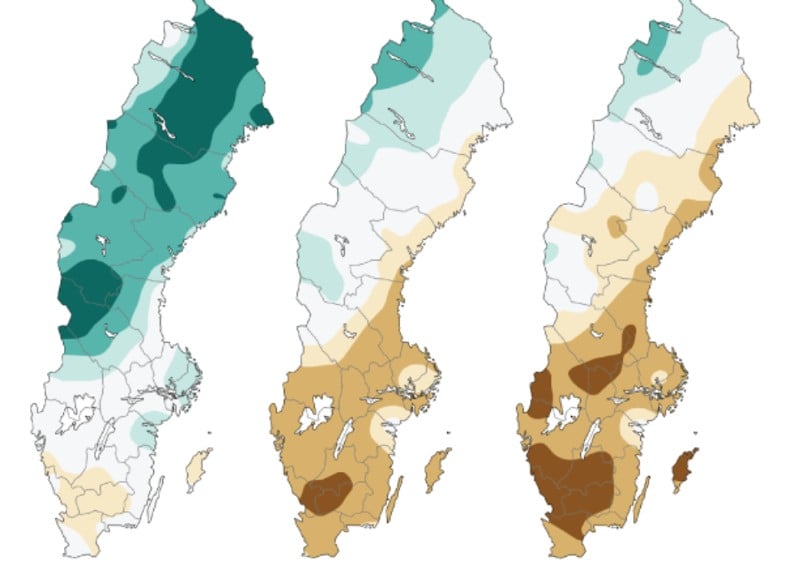IN MAPS: What's the water shortage situation in Sweden right now?

Sweden's state forecaster SMHI warned on Tuesday that large parts of Sweden are facing water shortages this summer, with several major rivers likely to dry up almost completely if it does not rain soon.
"There are different types of drought," Hugo Rudebeck, a hydrologist at SMHI said in a press release. "At the start of a dry period, drought occurs in the groundwater layer and in smaller watercourses. SMHI does not issue warnings about this. When the dry season has been persistent, water levels in larger watercourses begin to drop. It is this type of water shortage that we now issue a warning for."
SMHI expects extreme water shortages in the Fylleån, Viskan, Ljungbyån and Bolmån rivers, all of which are in Småland and/or Halland, and also in the Fyriså which flows through the city of Uppsala.

The areas where water shortages are feared stretch from Sweden's west coast over to the east. Graphic: SMHI
How low has rainfall been?
According to the agency, most of southern and central Sweden in May received half or less than half of the amount of rain expected based on the amount which fell in the same month between 1991 and 2020.
So far in June, no rain has fallen at all across most of the south and centre of the country (see red area in map below right).

Rainfall in May (map to the left) and so far in June (map to the right) is well below the normal level between 1991 and 2020. Graphic: SMHI
Groundwater levels already unusually low
If you look at the Geological Survey of Sweden's assessment of groundwater levels across Sweden, which is updated weekly, they are looking unusually low, whether you look at large aquifers (map below to the left), which remain full for long dry periods but take longer to replenish, or at small aquifers (map to the right), which fill up quickly but also dry out fastest.
The areas with the biggest immediate problems right now appear to be to the south of Halland, the west of Småland, and the north of central Skåne.

Graphic: Geological Survey of Sweden
In its report on the groundwater situation at the end of May (map below left), the Geological Survey of Sweden warned that even if Sweden receives normal rainfall up until the end of July (map below centre), western Småland and southern Halland would have "unusually low" levels in smaller aquifers.
This will cause severe problems for people who rely on their own spring or well to get their water supplies, but is also likely to mean hosepipe bans across much of the affected area.
If the rainfall continues to be low, a much larger area will be affected (map below right).

By the end of July, western Småland and southern Halland will be facing water shortages even if rainfall is normal. Graphic: Geological Survey of Sweden
In the event of a water shortage, a hosepipe ban could be put in place in certain areas, but you will still be permitted to use water for cooking, drinking and for personal hygiene.
Comments
See Also
"There are different types of drought," Hugo Rudebeck, a hydrologist at SMHI said in a press release. "At the start of a dry period, drought occurs in the groundwater layer and in smaller watercourses. SMHI does not issue warnings about this. When the dry season has been persistent, water levels in larger watercourses begin to drop. It is this type of water shortage that we now issue a warning for."
SMHI expects extreme water shortages in the Fylleån, Viskan, Ljungbyån and Bolmån rivers, all of which are in Småland and/or Halland, and also in the Fyriså which flows through the city of Uppsala.

The areas where water shortages are feared stretch from Sweden's west coast over to the east. Graphic: SMHI
How low has rainfall been?
According to the agency, most of southern and central Sweden in May received half or less than half of the amount of rain expected based on the amount which fell in the same month between 1991 and 2020.
So far in June, no rain has fallen at all across most of the south and centre of the country (see red area in map below right).

Rainfall in May (map to the left) and so far in June (map to the right) is well below the normal level between 1991 and 2020. Graphic: SMHI
Groundwater levels already unusually low
If you look at the Geological Survey of Sweden's assessment of groundwater levels across Sweden, which is updated weekly, they are looking unusually low, whether you look at large aquifers (map below to the left), which remain full for long dry periods but take longer to replenish, or at small aquifers (map to the right), which fill up quickly but also dry out fastest.
The areas with the biggest immediate problems right now appear to be to the south of Halland, the west of Småland, and the north of central Skåne.

In its report on the groundwater situation at the end of May (map below left), the Geological Survey of Sweden warned that even if Sweden receives normal rainfall up until the end of July (map below centre), western Småland and southern Halland would have "unusually low" levels in smaller aquifers.
This will cause severe problems for people who rely on their own spring or well to get their water supplies, but is also likely to mean hosepipe bans across much of the affected area.
If the rainfall continues to be low, a much larger area will be affected (map below right).

By the end of July, western Småland and southern Halland will be facing water shortages even if rainfall is normal. Graphic: Geological Survey of Sweden
In the event of a water shortage, a hosepipe ban could be put in place in certain areas, but you will still be permitted to use water for cooking, drinking and for personal hygiene.
Join the conversation in our comments section below. Share your own views and experience and if you have a question or suggestion for our journalists then email us at [email protected].
Please keep comments civil, constructive and on topic – and make sure to read our terms of use before getting involved.
Please log in here to leave a comment.